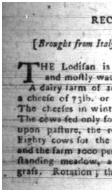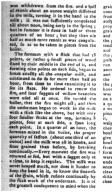[ Receipt for Making Parmesan Cheese ] Arthur Young
Date: 1791/11/05
Source:
Nova Scotia Magazine
Institution: Nova Scotia Archives
| Source Origin: Nova Scotia Newspapers on Microfilm
| Reference: Microfilm Reels 8062, 8063
Recipe for making cheese, brought from Italy, of milk and rennet. nn.688_89. Microfilm Reel 8063. Arthur Young also published the Annals of Agriculture and Other Useful Arts (London, 1790) that includes "The Mode of Cultivating and Dressing Hemp / Detached Observations on Hemp."
RECEIPT FOR MAKING PARMESAN CHEESE.
[Brought from Italy by Mr. Arthur Young, well known for his Labours in Agriculture.]
THE Lodisan is chiefly low grounds,
and mostly watered.
A dairy farm of 100 cows, makes daily
a cheese of 73lb. or 75lb of 28 ounces.
The cheeses in winter smaller but better.
The cows fed only four or five hours a day
upon pasture, the rest on hay at home.
Eighty cows for the dairy, 20 for calves,
and the farm 1000 perticas of land, 800 of
standing meadow, and 200 in corn and
grass. Rotation; the cows milked twice
a day, and give, with one another about
32 cocallis of 30 oz. of milk. The even-
ing’s milk is put to the morning’s. At
16 Italian hours of so in the morning, the
evening and morning’s milk, after being
skimmed, were put together into a boiler,
eight feet diameter at top, five feet three
inches deep at the bottom, about 2 ½ wide,
about 272 cocalli, and put under it two
faggots of wood, which made the milk ra-
ther more than lukewarm; then the boiler
was withdrawn from the fire, and a ball
of rennit about an ounce weight dissolved
in the milk, turning it in the hand in the
milk; it was not sufficiently coagulated
till about noon, being early in the spring;
but in summer it is done in half or three
quarters of an hour; but they then use
half as much more rennit as was coagula-
ted, so as to be taken in pieces from the
boiler.
The foreman with a stick that had 18
points, or rather 9 small pieces of wood
fixed by their middle in the end of it, and
forming nine points on each side, began to
break exactly all the coagular milk, and
continued to do so for more than half an
hour, from time to time examining it to
see its state. He ordered to renew the
fire, and four faggots of willow branches
were used all at once. He turned the
boiler, that the fire might act; and then
the underman began to work in the milk
with a stick like the above, but with only
four smaller sticks at the top, forming 8
points, four at each side, a span long
each point. In a quarter of an hour, the
foreman mixed in the boiler, the proper
quantity of saffron (about one third of an
ounce) and the milk was all in knobs, and
finer grained than before, by breaking
continually.--Every moment the fire was
renewed or fed, but with a faggot only at
a time, to keep it regular. The milk was
never heaped much, nor does it binder to
keep the hand in it, to know the fineness
of the grain, which refines continually by
the stick work of the underman. It is of
the greatest consequence to mind when the
grain begins to take consistence. When it
comes to this state, the boiler is hurried
from the fire, and the underman immedi-
ately takes out the whey, putting it into
proper receivers. In that manner, the
grain subsides at the bottom of the boiler,
and leaving only in it whey enough to keep
the grain covered a little, the foreman, ex-
tending himself as much as he can over,
and in the boiler, unites with his hands
the grained milk, making like a body of
paste of it; then a large piece of linen is
run by him under that body of paste, while
another man keeps the four corners of it,
and the whey is directly again put into
the boiler, which facilitates the raising
the paste, which is put for a quarter of an
hour into the receiver, where the whey
was in the linen: The boiler is then put
on the fire to extract a poor cheese; after
a quarter of an hour, the paste is put into
a wooden form without top or bottom; a
piece of wood like a cheese, put on top of
it, putting, and gradually increasing
weights upon it; in the evening, the
cheese so formed, is carried into the ware-
house, where, after 24 hours, they begin to
give the salt. It remains in that ware-
house 15 or 20 days, but in summer only
from 8 to twelve, where the crust will be
formed, when it is carried into another
ware-house. Then turn all the cheeses
under six months every day; after that,
once in 46 or 60 hours, keeping them
clean, otherwise they acquire a bad smell,
distinguished by the name of grained
cheese.
Download: Transcription | Images

